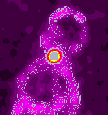
Adaptive optics near-IR imaging of NGC2992 - unveiling core structures related to radio figure-8 loops
Scott C. Chapman1, Simon L. Morris2, Almudena Alonso-Herrero3, Heino Falcke4
1 University of British Columbia, Dept. of Physics & Astronomy, Vancouver BC Canada, V6T 1Z42 Dominion Astrophysics Observatory, National Research Council of Canada, Victoria, B.C. V8X 4M6, Canada
3Steward Observatory, the University of Arizona, Tucson, AZ 85721, USA
4 Max-Planck-Institut für Radioastronomie, Auf dem Hügel 69, 53121 Bonn, Germany (hfalcke@mpifr-bonn.mpg.de)
Monthly Notices of the Royal Astronomical Society, in press
Abstract:
We present near-IR adaptive optics, VLA radio
and HST optical imaging of the nearby Seyfert galaxy
NGC2992.
Spiral structure and an extension to the West are traced down to the
core region at the limiting resolution of our near-IR images.
A faint, diffuse loop of near-IR and radio emission is also observed to the
north, embedded within the prominent 2"
radio loop previously observed to the northwest.
Near-IR color maps, and CO narrowband imaging,
are then used to identify which regions may not be
purely reddened stellar populations.
Our new data provide evidence that the VLA radio-loop morphology in
the shape of a figure-8
represents two components superimposed:
1) outflow bubbles out of the plane of the disk, coincident with
the extended emission line region (EELR);
2) star formation along the spiral arm within the galaxy disk and through
the dust lane.
The near-IR continuum emission associated with the outflowing radio bubbles
suggest that the radio loops are driven by the active nucleus.
Paper: Available in full length as PostScript and LaTex (AAS LaTex) Format.
Other publications can be found here.
Questions: Heino Falcke, hfalcke@mpifr-bonn.mpg.de